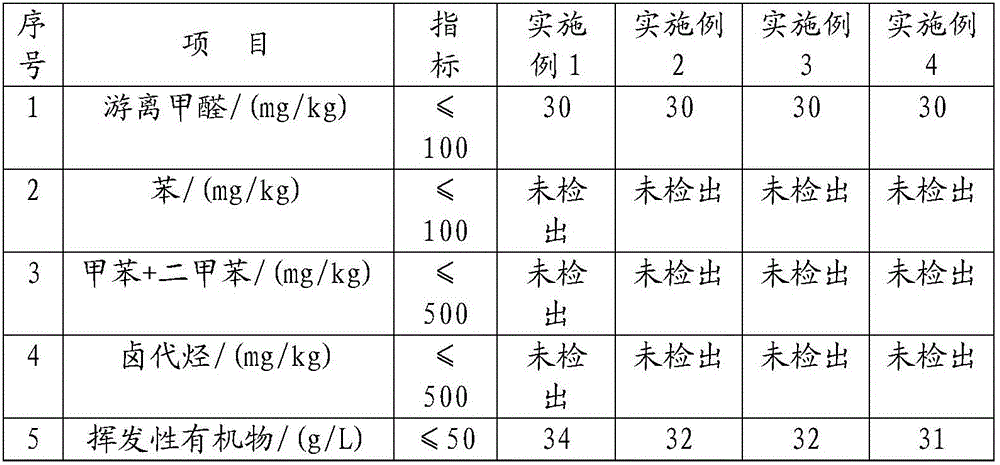Environment-friendly wall surface interfacial agent and preparation method thereof
A kind of interface agent, environment-friendly technology, applied in the direction of coating, etc., can solve the problems of low sealing force and bonding strength, not durable aging resistance, insufficient wall penetration, etc., and achieve good water resistance and enhanced bonding force, improve the effect of storage stability
- Summary
- Abstract
- Description
- Claims
- Application Information
AI Technical Summary
Problems solved by technology
Method used
Image
Examples
preparation example Construction
[0027] The preparation method of the above-mentioned environment-friendly wall interface agent comprises the steps as follows:
[0028] S1 Add deionized water and polyvinyl alcohol in proportion to the reactor and heat up to completely dissolve, then add EDTA, sodium bicarbonate in sequence, then slowly add ammonium persulfate, vinyl acetate, and butyl acrylate dropwise to synthesize polyvinyl acetate emulsion, and set aside ;
[0029] S2 Add deionized water and polyvinyl alcohol in proportion to the reaction kettle and heat up to completely dissolve, add functional additives and react for 1.5 hours, then cool to obtain a modified polyvinyl alcohol solution, set aside;
[0030] S3 Finally, add the polyvinyl acetate emulsion prepared in step S1 and the functional emulsion, defoamer, and bactericide in sequence to the modified polyvinyl alcohol solution obtained in step S2 and stir evenly to obtain a finished product.
Embodiment 1
[0032] Add 59.74g of deionized water and 6g of polyvinyl alcohol into the reaction flask and raise the temperature to 85°C for 1 hour, then add 0.045g of EDTA and 0.065g of sodium bicarbonate in turn after cooling down to 72°C, then slowly dropwise add 0.15g of ammonium persulfate and 28g of vinyl acetate Ester, 6g butyl acrylate, synthetic non-volatile matter content is that the polyvinyl acetate emulsion of 40% is standby;
[0033] Then 70.2g of deionized water and 2.0g of polyvinyl alcohol 1788 were added into the reaction flask and the temperature was raised to 85°C for 1h. Add 0.2g titanate coupling agent to react for 1.5h, then cool to obtain a modified polyvinyl alcohol solution, which is set aside;
[0034] Finally, 17.5 g of prepared polyvinyl acetate emulsion, 10.0 g of VAE emulsion, 0.05 g of defoamer, and 0.05 g of bactericide were sequentially added into the modified polyvinyl alcohol solution and stirred evenly to obtain a finished product.
Embodiment 2
[0036] Add 59.74g of deionized water and 6g of polyvinyl alcohol into the reaction flask and raise the temperature to 85°C for 1 hour, then add 0.045g of EDTA and 0.065g of sodium bicarbonate in turn after cooling down to 72°C, then slowly dropwise add 0.15g of ammonium persulfate and 28g of vinyl acetate Ester, 6g butyl acrylate, synthetic non-volatile matter content is that the polyvinyl acetate emulsion of 40% is standby;
[0037] Then, 71.0 g of deionized water and 2.0 g of polyvinyl alcohol 1788 were added into the reaction flask and the temperature was raised to 85° C. for 1 h. Add 0.4g titanate coupling agent and react for 1.5h, then cool to obtain a modified polyvinyl alcohol solution, which is set aside;
[0038] Finally, 12.5 g of prepared polyvinyl acetate emulsion, 14.0 g of VAE emulsion, 0.05 g of defoamer, and 0.05 g of bactericide were sequentially added into the modified polyvinyl alcohol solution and stirred evenly to obtain a finished product.
PUM
 Login to View More
Login to View More Abstract
Description
Claims
Application Information
 Login to View More
Login to View More - R&D
- Intellectual Property
- Life Sciences
- Materials
- Tech Scout
- Unparalleled Data Quality
- Higher Quality Content
- 60% Fewer Hallucinations
Browse by: Latest US Patents, China's latest patents, Technical Efficacy Thesaurus, Application Domain, Technology Topic, Popular Technical Reports.
© 2025 PatSnap. All rights reserved.Legal|Privacy policy|Modern Slavery Act Transparency Statement|Sitemap|About US| Contact US: help@patsnap.com



